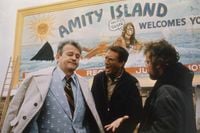Fifty years ago, a film emerged that would forever change the landscape of cinema and summer blockbusters. Steven Spielberg’s 1975 thriller Jaws not only terrified audiences but also set a new standard for suspense and storytelling. Today, as fans worldwide gather to celebrate its golden anniversary, the legacy of this iconic movie continues to ripple through popular culture and the very waters of Martha’s Vineyard, where much of the film was shot.
“Jaws” first swam into theaters on June 20, 1975, marking the second feature film directed by a then 26-year-old Spielberg. Despite being early in his career, Spielberg’s vision and resilience turned a project plagued by setbacks into a cinematic masterpiece. The making of the film was famously fraught with challenges, including a mechanical shark that consistently malfunctioned in the salty Atlantic waters off Martha’s Vineyard. Spielberg candidly described the experience as “both the worst and greatest experience of my career,” according to the 2010 documentary Jaws: The Inside Story.
Richard Dreyfuss, who starred in the film, recalled that principal photography began without a working mechanical shark, a partly cast crew, and an unfinished script. This adversity forced Spielberg to innovate, focusing on the unseen terror lurking beneath the water’s surface. As he explained on a 1992 episode of 60 Minutes, the suspense stemmed from what wasn’t shown—the legs kicking in the water, the camera’s point of view just above the surface, or the ominous ripples—heightening the audience’s fear of the unknown.
Indeed, the shark, affectionately nicknamed “Bruce” after Spielberg’s lawyer Bruce Ramer, did not fully appear on screen until one hour and 21 minutes into the film. This delay in revealing the creature contributed significantly to the film’s tension and success. The mechanical sharks used were massive, with one cast measuring 25 feet long and weighing over 1,200 pounds, yet they were vulnerable to corrosion from saltwater, leading to frequent breakdowns.
The film’s narrative was adapted from Peter Benchley’s 1974 novel, which he only titled “Jaws” twenty minutes before it went to print. Benchley admitted he wasn’t entirely sure what the word meant but appreciated its brevity. The novel’s paperback cover, featuring the now-iconic image of a woman swimming above a lurking shark, was illustrated by Roger Kastel and later became the film’s poster art.
While the fictional Amity Island was inspired by the neighboring Nantucket, the actual filming took place primarily on Martha’s Vineyard, Massachusetts. Many locals appeared in cameo roles, and the island remains a pilgrimage site for fans. This year, enthusiasts from around the globe are converging on Martha’s Vineyard to honor the film’s 50th anniversary with celebrations that include tours of filming locations, museum reunions, and special exhibits.
Among the attendees is Dean Cubitt from Wales, a passionate Jaws memorabilia collector who is eager to explore the island’s famed spots. Nicholas Blatt, who visited in 1986 and fondly remembers the island’s resemblance to the film’s setting, plans to dress as Quint, the grizzled shark hunter immortalized by Robert Shaw. Greg Dole, who played the Coast Guard sonar operator in the memorable “fake shark fin” scene, will be signing autographs and reminiscing at the Martha’s Vineyard Museum Reunion alongside Jonathan Searle, the local police chief who appeared as a child in the film.
Artist Timothy Thomas, known for his Jaws-themed paintings, is also showcasing his work at the museum and local stores, adding to the festive atmosphere. Fans like Michael Smith cherish the chance to connect with fellow enthusiasts in person, while Bill and Emily Desenberg from California have been planning their trip for over a year to immerse themselves in the island’s Jaws-related festivities.
Universal Studios parks in Hollywood and Florida are also joining the celebration. Hollywood’s Studio Tour still features the famous Jaws encounter, and through August 10, 2025, guests can enjoy photo opportunities with a hanging shark, meet-and-greets with characters like Captain Quint and Chief Brody, and dine at the temporarily rebranded Amity Island Cafe. Meanwhile, Universal Studios Florida, although having retired its Jaws ride in 2012, displays the hanging shark year-round and offers special photo ops and themed snacks through July 6. Nightly shows like CineSational: A Symphonic Spectacular incorporate John Williams’ unforgettable score, while the Universal Mega Movie Parade, running through November 13, features floats and characters from Jaws and other beloved films.
The film’s cast and crew stories add rich layers to its legacy. Spielberg was not the original director; he took over after the first director lost the role due to confusion between a shark and a whale. Spielberg initially wanted Lee Marvin for Quint, but he was unavailable, and Sterling Hayden was considered but couldn’t accept due to tax issues. Ultimately, Robert Shaw’s portrayal brought depth to Quint, whose haunting monologue about surviving the USS Indianapolis sinking was penned by screenwriter John Milius and synthesized by Shaw himself.
Richard Dreyfuss, who plays marine biologist Matt Hooper, was initially reluctant to join the project but later “begged for the part.” Roy Scheider landed the role of Police Chief Brody after a chance meeting with Spielberg, beating out Charlton Heston, whom Spielberg felt was too big a star for the role. Scheider also improvised the film’s most famous line, “You’re gonna need a bigger boat,” which has since become a cultural catchphrase.
Despite its troubled production—filming took 159 days instead of the planned 55, with the budget nearly tripling—the film’s impact was monumental. It became the first summer blockbuster, shattering box office records and winning three Oscars for sound, editing, and John Williams’ iconic score. It lost Best Picture to One Flew Over the Cuckoo’s Nest, but its influence on filmmaking and popular culture remains unmatched.
“Jaws” also pushed the boundaries of film ratings. It received a PG rating, stirring controversy since the PG-13 category wouldn’t exist until 1984. Jack Valenti, then-president of the Motion Picture Association of America, defended the rating by emphasizing the film’s portrayal of nature’s violence rather than human violence.
Today, as fans celebrate half a century of thrills, chills, and unforgettable scenes, “Jaws” stands as a testament to creativity born from adversity. Whether revisiting the island where it all began, enjoying themed events at Universal Studios, or simply humming that iconic dun-dun, dun-dun, the legacy of “Jaws” continues to captivate and inspire new generations.


